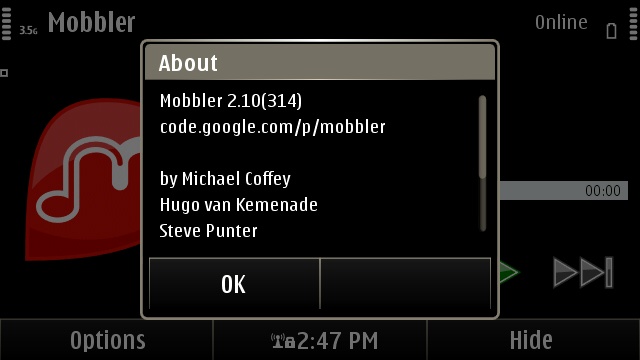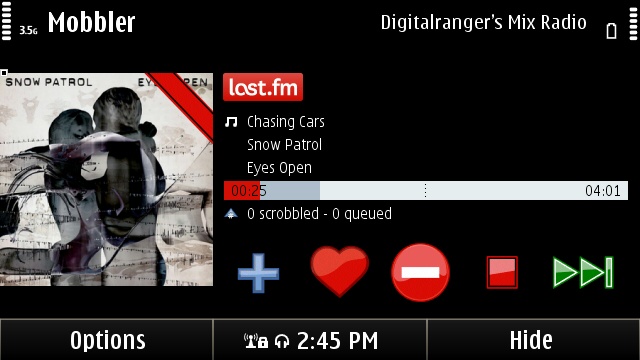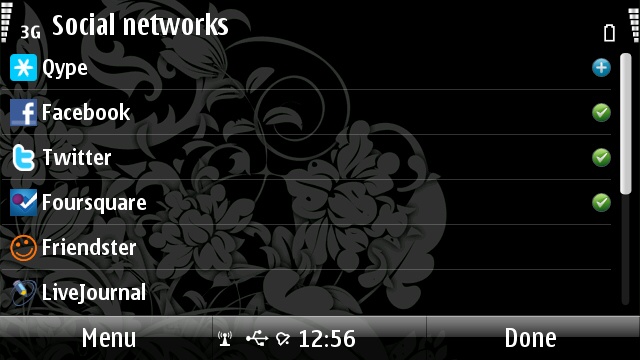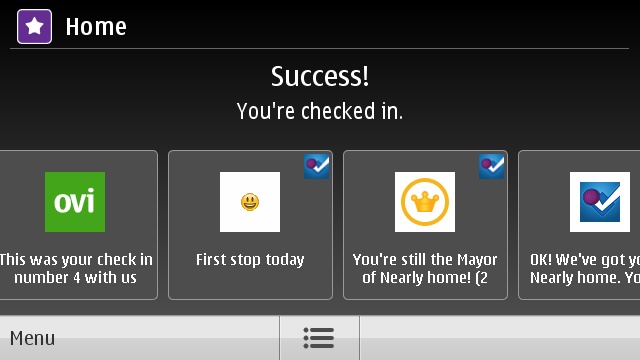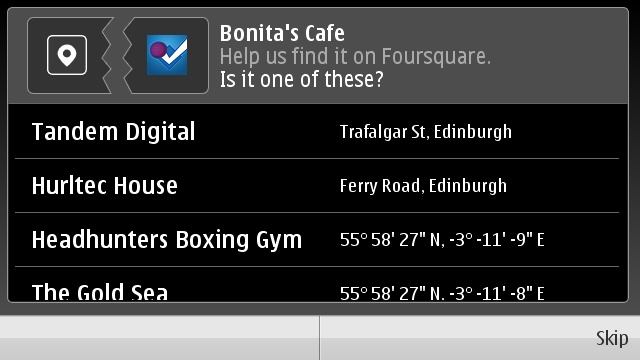You may remember a piece from me almost a year ago in which I gave six reasons why the Nokia N97 sucked and nine reasons why it still 'ruled'? In this followup piece, I extend, for the first time, my popular 'Pimping' tutorial series to a touchscreen Symbian phone - and not just any old smartphone, but the one that everyone loves to hate, the flawed flagship that for many people epitomises some of the decisions that sealed Symbian's fate. However, I'm a geek, you're a geek, and the N97, now available second-hand for under £100, is about to get 'pimped'...

First things first though. Summarising my earlier article, the Nokia N97 sucked because:
there's a lot of plastic and relatively little metal (for a flagship).initial hardware had a poorly designed camera glass protector (which scratched the thing it was supposed to protect) and a badly shielded GPS antenna.it's underpowered in terms of CPU, RAM and internal (system disk, C:) flash memory. Hit it hard with running apps and something will break. And if you get download-happy with Nokia-optional 'upgrade' components, you'll run out of room on C: and you'll be facing a backup/re-format/restore cycle to try and recover the situation. has a touch interface that's clearly still first generation and occasionally downright confusing.has a qwerty keyboard that's minimalist at best, with an offset space bar (that you do get used to in seconds, to be fair).has stereo speakers that are just about the tinniest I've heard - and they're not the loudest either.
And, balancing the above (somewhat damning points) were nine reasons why the device still ruled:
transflective screen means that it's still visible in brightest sunlight (though admittedly not exactly vibrant).'hero' battery life. Powered by the all-conquering BP-4L 1500mAh Li-Poly cell and you can change batteries in a jiffy.built-in FM transmitter is a God-send on long car journeys.camera glass protection not only stops fingerprints building up, it also gives an instant way to load up Camera.talking of which, the N97's Carl Zeiss 5 megapixel stills camera is still decent, even by 2011 standardscavernous 32GB built-in mass memory, plus microSD expansion.surprisingly good QWERTY keyboard (now that long-press symbol insertion and copy/paste are all catered for).the hinge angle makes the N97 perfect for displaying media and generally presenting information to you (e.g. in Web pages - see below).it's a Nokia. And a recent-ish one, so we're talking free Ovi Maps navigation and other goodies.
Quite a tug of war between pros and cons then. But, as with the other 'Pimping' articles in this All About Symbian series, the idea is to take yesterday's 'discarded' hardware and pimp it to something approaching modern standards.
It can be done - because I've done it, with a few compromises along the way. What's needed from a hardware and software perspective and where do you get it all from?
I mentioned above that the N97, possibly because of its flawed repututation, is now available at rock bottom prices on eBay. I know because I bought one, in the interests of researching this piece. I paid a fraction over £100, though others went for just less. Still a steal for a 'flagship' phone that was selling for £450+ two years ago. Incidentally, owning and using a smartphone that can be replaced for such a relatively low amount also makes one rather less 'precious' about dropping it, scratching it or otherwise exposing it to the rigours of daily life without a safety net....
If you fancy doing the same, then there's one huge usability note - get the black one. Having owned the white N97 before, I had often remarked how crazy it was to have the QWERTY key legends light up in white on white keys. In bright light and pitch darkness there's no problem, but in everything in between, you just can't read which key is which. As shown below, the black N97 colour scheme solves this with perfect key legend visibility in all light conditions.

The black N97 also doesn't (ahem) show the dirt like the white one does - the latter is infamous for developing a discoloured d-pad.
As previously documented on AAS, if you do pick up an N97 second-hand at a knock-down price, watch out for devices made in the first few months after the N97 shipped: camera glass sliders that were mounted too close and which scratched the glass, plus GPS antennae that were badly shielded, were the order of the day. Thankfully, it seems that anything made after about Christmas 2009 had both issues sorted out. Certainly the N97 I purchased was flawless for camera glass and GPS. Just something to be aware of.
Now, this may well be me just being fastidious, but there are practical advantages too, to giving the N97 a good physical spring clean. Take a clean cotton cloth and some light screen polish (e.g. that for LCD monitors) and clean up that relatively delicate resistive touchscreen - you don't want any particles of grit gouging into it. You'll also find that a polished and smooth screen makes the touch interface far more sensitive and pleasurable.

And clean up the QWERTY keyboard too, you never know where the previous owner's fingers have been! A cotton bud can help you clean up the camera bay's two regions too. It all helps.

One of the biggest 'pros' above was the N97's use of Nokia's hero battery, the Li-Poly BP-4L rated at 1500mAh. This can power the N97 for a couple of days of normal use and with a spare in your pocket you're good to go for a lot more, in somewhat stark contrast to many 2011 smartphones. Buying up spares on the Internet has always been tricky. Nokia's own site quotes top prices, prohibitively so, while unscrupulous eBay sellers show what appear to be genuine batteries but turn out to be fakes. I recommend Amazon here, with the genuine BP-4L currently on special offer for £5. Avoid third party sellers with less than perfect feedback and examine the holograms with a fine toothcomb to prove their origin etc.
You can charge the BP-4L in the N97, of course, but it's even better to charge up your spares in something like this.

It goes without saying that you'll need latest firmware on your N97. Various carrier-supplied N97s may be stuck on 'older' versions, but as long as the device is showing (*#0000# on the dialler screen) v21 or higher then you'll be fine. You can update over the air, but if this is part of inheriting an N97 from someone else and you're wiping/starting again anyway then it makes sense to use Ovi Suite to reinstall the firmware from scratch and then do an extra hard reset (*#7370# on the dialler, default lock code 12345) just in case.
And no, the mythical v30 firmware never did get released by Nokia, I'm not even convinced that it ever did exist!
Mainly supplied through 'Sw_update' (in your Applications folder), Nokia tried to push a fairly large number of patches and additions. Here's the first huge tip to pimping the N97 - ignore most of these. The single most critical resource in your N97 is the system disk space (disk C) and many of Nokia's patches and updates insist on spreading themselves on C:.

In particular, avoid:
Gig finder (non essential)N-Gage (games system, now sadly defunct)Nokia Messaging (run a mile, this will eat your disk C: for breakfast and then return later to mop up the scraps)Ovi Music (non essential for most people)Quickoffice (if you do need the latest version, with full document editing version then get it from the Ovi Store instead, to update in one 6MB fell swoop rather than a half-hearted Sw_update upgrade and subsequent editing patch)
Updates you probably will need include:
MailforExchange (if you plan to use this to integrate with Google etc and feel lucky)Nokia Maps update (v3.4 currently offered, it's unlikely that v3.6 will make it back to the N97. 3.4 brings free navigation and is a worthwhile 10MB install on disk C: in my opinion)Time zone update (hey, it's small)Memory reorganiser (also small and does save a few Megabytes on disk C: though I'm not sure how long its effects last)Here and now (also small)
As a point of reference, with v21 firmware and with Nokia Maps 3.4, with the Quickoffice latest editing version installed (you know it makes sense, this having a full qwerty keyboard), with a realistic web and Messaging cache and with all the apps mentioned positively below, my bought-up black N97 is running with just over 20MB free on disk C:. This isn't a huge amount, but it's hopefully a stable state, given that I don't plan to add any other disk C:-munching monstrosities...

There are two possible approaches to managing the other precious resource on the N97: RAM. And no, this is totally different to disk C: space, even though Nokia confuses the issue by calling them both 'memory'.
Approach one is to let Symbian OS do its thing, closing apps when you run out and generally trying to fit a quart into a pint pot. It works well enough if you're fairly gentle with your apps and 'Exit' the heavy duty ones (Web, Photos, Maps, etc) manually when you're done with them.
Approach two is to install RAMBlow, which runs every so often and 'tidies up', terminating running apps which you haven't used for a set period of time and optionally also compressing and defragmenting RAM to give you the maximum possible free. The system really does work quite well and RAMBlow also doubles as a task manager, as you can see below.


Applications that you need kept running at all times (because you want them instantly available, even a day or so later - Podcasting, Music player, Clock, in my case) can be toggled as 'protected', meaning they won't get terminated as part of a RAM clean-up.
The only catch is that RAMBlow is relatively expensive, at $15 - but there's a free trial version so you can justify it to yourself (or not) after a week of actual use. With RAMBlow installed you should never see an 'Out of memory' error again. In theory!
Third party applications to make a beeline for - and to avoid
Some of the most recent third party Symbian applications are built on Qt - involving the installation of the Qt libraries on your device. Up to 20MB worth, depending on configuration, also on disk C: of the target device, making the N97 extremely unsuitable for these Qt apps. Although this does mean that, for the N97, the software world is virtually frozen in terms of new apps, there are still plenty of great third party applications that you should indeed make a beeline for.
Skype, in its pure Symbian form, is well worth grabbing from m.skype.com, as it works brilliantly and, for this AAS staffer at least, enables the mobile office to function even when I'm mobile.
Much has been said about Symbian's S60 5th Edition Web browser, so I won't repeat that all here, except to say that it's still crippled on the N97 because of the relative lack of free RAM. Instead, install the new '5.1 beta 2' version of Opera Mini 'for Symbian/S60' from m.opera.com. This works just as well as the old Java-based version, with the advantages that it uses less RAM, runs faster, starts faster and is better integrated into the N97's hybrid touch/qwerty interface.

PhoneTorch works well to turn the N97 into a dual LED torch, for those forays into the back yard after dark, though the camera glass shutter does cover the LEDs in normal use, so you have to go through the added steps of opening the shutter and then Exiting the Camera app first. Ah well.
One of the biggest losses to day to day usability on the N97 is that of telling the time - the keylock screen just pops up a 'how to unlock' message - the underlying display may or may not show a clock. Make a beeline for the excellent Key Lock Clock. Once installed (and the device restarted), this utility acts to pop up a clock at normal brightness whenever you press the main N97 menu button - without disturbing the keylock itself.


I mentioned above that Nokia Messaging/Email is certified death to the N97. But what can replace it, that doesn't cripple the limited system disk in the same way? I'm a Gmail die-hard and have made the existing Gmail Java-based client work for me (hint: go into Settings/Application manager/Gmail/Suite settings and turn off the virtual d-pad and function keys!) - this works (almost) completely in the cloud and so there's no system disk impact at all. For other email systems I'd probably turn (as I have in the past) to the ultra-quirky but also ultra-configurable Profimail - you'll hate it for the first hour, then the penny will drop and you'll love it for the rest of your life.
Other S60 5th Edition favourites which made their way onto the editorial pimped N97 were Nokia Internet Radio, a bundle of Offscreen utilities, including Egg Timer and Converter, the official Facebook client, the popular Gravity Twitter client, and the ubiquitous Google Maps (from m.google.com, even though it's put in the shade to some degree by Nokia Maps these days).
In addition, with the N97's tilted screen being perfect for video watching, must downloads are Google's YouTube client (even though the streams this uses aren't as high quality as on other non-Symbian phones, sadly), and (if you're in the UK) BBC iPlayer, letting you watch live and catch-up TV, including downloads for watching programmes on journeys with intermittent connectivity.
I mentioned brightness and keylocking above. The N97's screen is transflective LCD and the impact of running the screen 'frontlight' on full brightness is quite a bit less than if the same were done with (say) a white theme on a modern AMOLED device. Thus, there's no real reason not to go into Settings/Phone/Display and crank the 'Light sensor' up to full. Your N97's display will almost look modern. Almost!

On the keylocking front, I find all the S60 5th Edition devices to be rather annoying in that with the screen off, it's not clear whether the screen's just powered down and waiting for a keypress or whether the device is actually keylocked. So you toggle the keylock and... it turns that the screen was just off, so congratulations, you just locked it for real. And now you've got to wait a second and toggle it again to bring the device back on again.
I avoid this scenario by going into Settings/Phone/Phone management/Auto keyguard and turning the 'Keypad autolock period' 'Off'. Thus, the only time the N97 will be keylocked is when I've done it explicitly. If the screen is then off under normal circumstances I know the device isn't keylocked and can just press the main front-face menu button to bring it back to life.


The N97's variant of S60 5th Edition (in)famously introduced the widgetised homescreen. I say 'infamously' because the default selection included two huge RAM guzzlers: Facebook and Accuweather. Delete these two widgets and the N97 starts to sing. Well, hum at least, with well over 10MB more free RAM.
Modern Symbian^3 phones now have up to three such homescreens, but you may recall that I'm not so sure having more than one is a good idea from a conceptual point of view. In which case the single homescreen of the N97 is perfectly good enough. My pimped N97 ended up with Calendar, Music player, Favourite contacts and application shortcuts on its homescreen. All offline content, you'll note, but this has RAM and battery life benefits. Besides which, every online widget I've tried, whether email or social or weather, has required me to tap it anyway, to bring up the full app for any serious use - so why not simply have that application as a 'shortcut' and save lots of homescreen real estate?
Also a help with RAM is to use a simple theme for your homescreen and menu: a suitable selection are built into the N97, thankfully. Try to resist the temptation to install that pretty 3MB theme from your favourite novelties site - it'll slow the N97 down and will decrease usability.
Music fill-ups
The N97 comes with 32 glorious Gigabytes to fill up, of course. Not counting whatever you also add to the microSD slot. By all means drag across your 20GB music collection, but be warned that thousands of tracks will take hours to index when you next 'Refresh' the N97's Music library.

Instead, I'd suggest copying on music a few hundred tracks at a time, stopping to refresh after each batch and testing performance and response as you go. Yes, the N97's mass memory and processor (and Music application) should all be faster, but we have to work with what we've got - and as flaws go, this limitation is relatively minor.
Once in place, having a huge music library 'on tap' is just superb, especially as it's all accessible via multimedia headset (each N97 shipped with one) or FM transmitter to your car's stereo.
_____________________________________
A year ago, I wrote this, about the N97:
There is absolutely nothing it does which is better than every other phone in the world. But there's also (almost) nothing it can't do.
This still largely holds true. It's a horribly flawed device, possibly one of the biggest screw-ups in terms of hardware specifications in Nokia's history, and it attracted terrible blame as a result. But for the Symbian enthusiast, for the convergence fan, for the hardened 'pimper', the N97 still offers a lot of geek fun and a huge amount of mobile functionality in the one body.
Enjoy your Nokia N97, whether as main or backup device in 2011. And comments welcome - perhaps you've picked up an N97 bargain yourself recently?


































